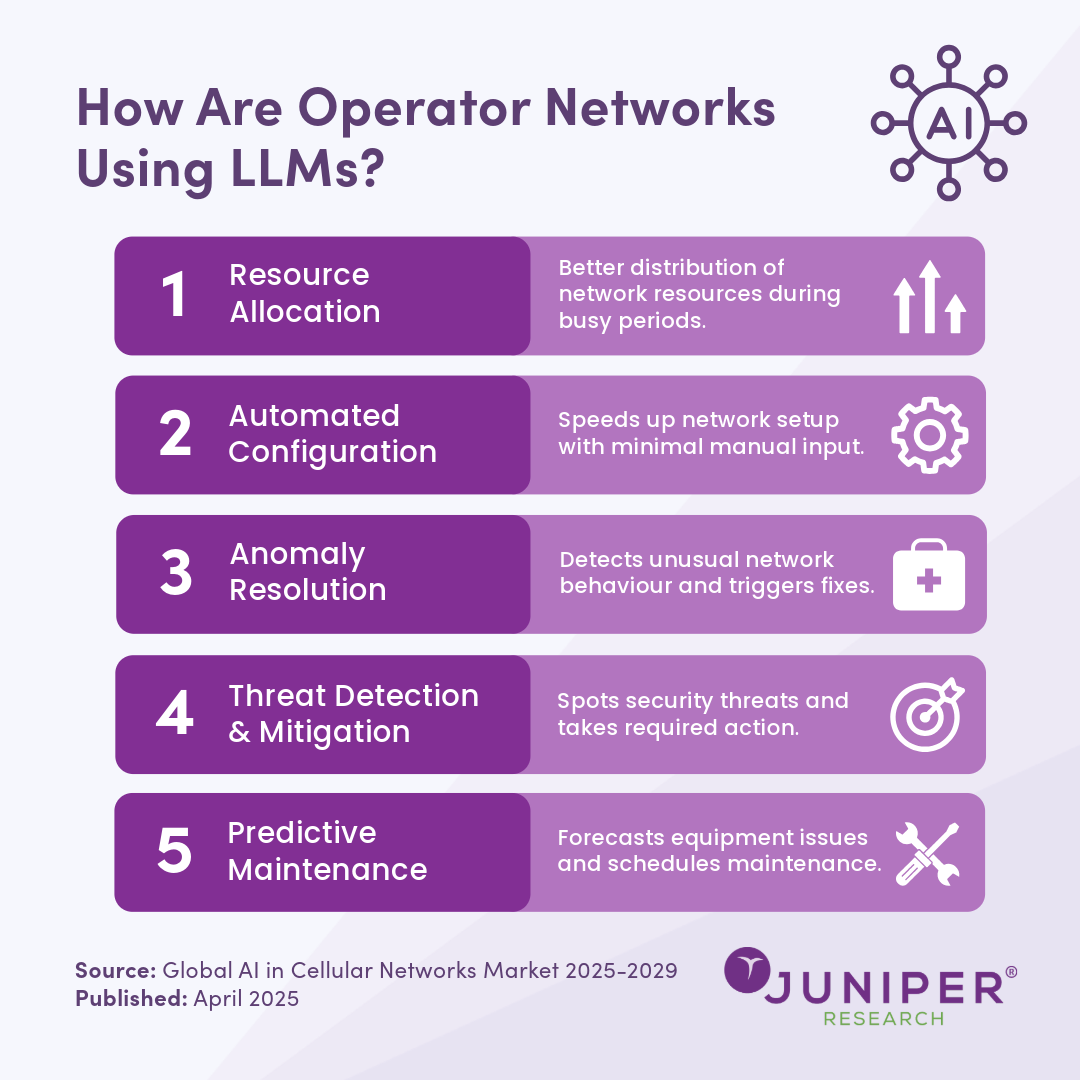How Are Operator Networks Using LLMs?


As telecom networks become more software-defined and data-driven, the pressure is on operators to boost efficiency, reduce downtime, and stay ahead of increasingly complex demands.
Our latest research has identified several key ways that large language models (LLMs) are now stepping into the telecom space; not as chatbots, but as intelligent agents capable of transforming network operations:
Resource Allocation
At the heart of any telecom network is the challenge of resource allocation; ensuring bandwidth, compute, and spectrum are distributed effectively to match user demand.
LLMs help operators take this to the next level by continuously analysing real-time network data and traffic patterns. By understanding fluctuations in usage, they can proactively reallocate resources to high-demand areas, balancing loads and preventing bottlenecks. This results in better network performance, particularly during peak times, without overspending on capacity that may go unused.
Network Configuration
Manual configuration of network parameters is time-consuming, error-prone, and increasingly impractical in large-scale, dynamic environments.
LLMs enable automated configuration by interpreting documentation, learning from past setups, and adjusting parameters to match current needs. Whether deploying new sites or reoptimising existing infrastructure, LLMs can streamline this entire process; resulting in faster rollouts, fewer configuration errors, and a lighter workload for network engineers.
Anomaly Detection and Resolution
Network anomalies, from signal interference to routing failures, can severely impact service quality - and go undetected by traditional network maintenance systems.
LLMs, however, excel at identifying patterns and spotting irregularities in complex datasets. By continuously learning from network logs and behaviours, they can detect anomalies as they emerge, diagnose the root cause, and either trigger an automated fix or provide engineers with clear, actionable recommendations. This dramatically reduces MTTR and helps maintain high service availability.
Threat Detection and Mitigation
With cyberattacks on the rise, operators are under pressure to secure their networks in real time.
LLMs play a vital role here by spotting unusual traffic behaviours and correlating signals across diverse data sources - from network logs to system alerts. Unlike traditional security tools that rely on known signatures, LLMs can identify novel threats based on behavioural anomalies. This allows them to flag potential intrusions early and recommend mitigation strategies or automatically activate protective protocols; resulting in a more agile and adaptive security posture.
Predictive Maintenance
Downtime is costly - and often preventable. LLMs can process vast amounts of historical performance and maintenance data to predict when components are likely to fail.
Whether it’s detecting overheating in base stations or identifying early signs of fibre degradation, LLMs enable operators to act before issues cause outages. By integrating with maintenance systems, they can also schedule proactive repairs and automatically generate work orders, minimising disruption and extending the lifespan of critical infrastructure.
These five capabilities only scratch the surface of what LLMs can offer. As networks evolve to support 5G, edge computing, and even early 6G experimentation, the need for adaptive, intelligent operations will only grow - and when combined with other AI models and real-time analytics, are well-positioned to become the decision-making engine behind next-generation networks.
Source: Global AI in Cellular Networks Market 2025-2029
Download the Whitepaper: 3 Key Trends Driving Operator Investment in Cellular Network AI in 2025
Read the Press Release: Operator AI Investment to Exceed $86bn Over the Next Four Years as ‘Zero Touch’ Becomes the Focus
Latest research, whitepapers & press releases
-
 ReportDecember 2025
ReportDecember 2025AI Agents for Customer Experience Platforms Market: 2025-2030
Our comprehensive AI Agents for Customer Experience Platforms research suite comprises detailed assessment of a market that is set to disrupt mobile communications. It provides stakeholders with insight into the key opportunities within the AI agents for customer experience platforms market over the next two years.
VIEW -
 ReportDecember 2025Fintech & Payments
ReportDecember 2025Fintech & PaymentseCommerce Fraud Prevention Market: 2025-2030
Our eCommerce Fraud Prevention research suite provides a detailed and insightful analysis of this evolving market; enabling stakeholders from financial institutions, law enforcement agencies, regulatory bodies and technology vendors to understand future growth, key trends, and the competitive environment.
VIEW -
 ReportNovember 2025Telecoms & Connectivity
ReportNovember 2025Telecoms & ConnectivityeSIMs & iSIMs Market: 2025-2030
Juniper Research’s eSIMs and iSIMs research suite offers insightful analysis of a market set to experience significant growth in the next five years. The research suite provides mobile network operators (MNOs), original equipment manufacturers (OEMs), and eSIM management and platforms vendors with intelligence on how to capitalise on the market growth, and guidance on how eSIM-only devices and sensors, SGP.42, in-factory provisioning, and iSIMs will change the competitive landscape.
VIEW -
 ReportNovember 2025Fintech & Payments
ReportNovember 2025Fintech & PaymentsModern Card Issuing Platforms Market: 2025-2030
Our Modern Card Issuing Platforms Market research suite provides a detailed and insightful analysis of this evolving market; enabling stakeholders from banks, financial institutions, fintech companies, and technology vendors to understand future growth, key trends, and the competitive environment.
VIEW -
 ReportNovember 2025Fintech & Payments
ReportNovember 2025Fintech & PaymentsDigital Wallets Market: 2025-2030
Our digital wallets research suite provides detailed analysis of this rapidly changing market; allowing digital wallet providers to gain an understanding of key payment trends and challenges, potential growth opportunities, and the competitive environment.
VIEW -
 ReportOctober 2025Fintech & Payments
ReportOctober 2025Fintech & PaymentsDigital Identity Market: 2025-2030
Juniper Research’s Digital Identity research suite provides a comprehensive and insightful analysis of this market; enabling stakeholders, including digital identity platform providers, digital identity verification providers, government agencies, banks, and many others, to understand future growth, key trends, and the competitive environment.
VIEW
-
 WhitepaperDecember 2025Telecoms & Connectivity
WhitepaperDecember 2025Telecoms & ConnectivityHuman + AI: Drivers of Customer Experience AI Agents in 2026
Our complimentary whitepaper, Human + AI: Drivers of Customer Experience AI Agents in 2026, examines the key drivers of the AI agents for customer experience platforms market in 2025.
VIEW -
 WhitepaperDecember 2025Fintech & Payments
WhitepaperDecember 2025Fintech & PaymentsBeyond Chargebacks: The True Cost of Fraud for Digital Commerce
Our complimentary whitepaper, Beyond Chargebacks: The True Cost of Fraud for Digital Commerce, examines the state of the eCommerce fraud prevention market; considering the impact of evolving digital fraud strategies, including key trends such as identity theft, account takeovers, chargebacks, policy abuse and friendly fraud.
VIEW -
 WhitepaperNovember 2025Telecoms & Connectivity
WhitepaperNovember 2025Telecoms & ConnectivityeSIM-only Devices: The Impact on Operators, Consumers, and IoT
Our complimentary whitepaper, eSIM-only Devices: The Impact on Operators, Consumers, and IoT, explores the challenges and opportunities for the three segments, with a particular focus on eSIM-only smartphones and SGP.42.
VIEW -
 WhitepaperNovember 2025Fintech & Payments
WhitepaperNovember 2025Fintech & PaymentsUnlocking the Next Stage of Growth for Modern Card Issuing Platforms
This free whitepaper analyses key trends shaping the modern card issuing space, and the ways in which modern card issuing platforms can capture growth.
VIEW -
 WhitepaperNovember 2025Fintech & Payments
WhitepaperNovember 2025Fintech & PaymentsTop 10 Fintech & Payments Trends 2026
Fintech is evolving fast. From stablecoins to agentic AI, our annual guide reveals the shifts redefining payments, digital identity, and the future of money in 2026. Download your copy today.
VIEW -
 WhitepaperNovember 2025Fintech & Payments
WhitepaperNovember 2025Fintech & PaymentsDigital Wallets: Empowering Financial Inclusivity
Our complimentary whitepaper, Digital Wallets: Empowering Financial Inclusivity, examines the state of the digital wallets market; considering the impact of digital wallets on different geographies, how they are shaping the modern payments landscape through lower transaction fees and promoting financial inclusivity for underbanked populations, and how they are competing with established payment methods.
VIEW
-
IoT & Emerging Technology
Juniper Research Unveils Top 10 Emerging Tech Trends to Watch in 2026
January 2026 -
Fintech & Payments
Digital Identity App Usage to Hit 6.2 Billion by 2030, Driven by Shift to Decentralised Models
December 2025 -
Telecoms & Connectivity
Travel eSIM Margins Under Pressure as Revenue per Gigabyte Falls 10% Globally in Two Years
December 2025 -
Telecoms & Connectivity
AI Agents to Power 1,000% More Customer Interactions for Enterprises Globally by 2027
December 2025 -
IoT & Emerging Technology
Global D2C Revenue Set for $370 Million Surge, But Satellite Operators Should Not Chase Full MNO Status
December 2025 -
Fintech & Payments
Digital Goods Fraud to Cost eCommerce Merchants $27 Billion Globally by 2030 as AI Tools Accelerate Attacks
December 2025




















